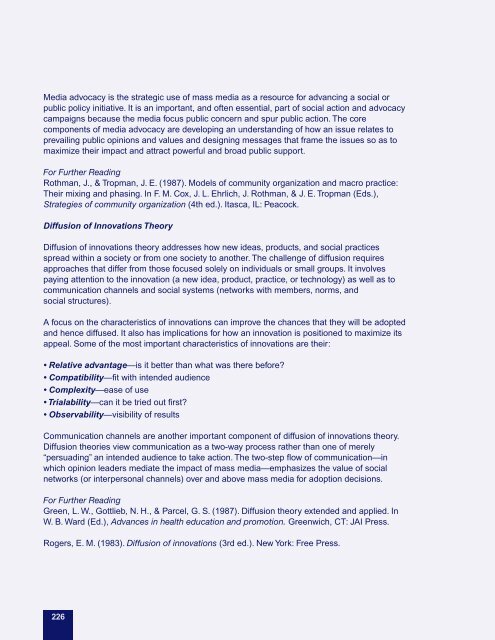pink-book
pink-book
pink-book
You also want an ePaper? Increase the reach of your titles
YUMPU automatically turns print PDFs into web optimized ePapers that Google loves.
Media advocacy is the strategic use of mass media as a resource for advancing a social or<br />
public policy initiative. It is an important, and often essential, part of social action and advocacy<br />
campaigns because the media focus public concern and spur public action. The core<br />
components of media advocacy are developing an understanding of how an issue relates to<br />
prevailing public opinions and values and designing messages that frame the issues so as to<br />
maximize their impact and attract powerful and broad public support.<br />
For Further Reading<br />
Rothman, J., & Tropman, J. E. (1987). Models of community organization and macro practice:<br />
Their mixing and phasing. In F. M. Cox, J. L. Ehrlich, J. Rothman, & J. E. Tropman (Eds.),<br />
Strategies of community organization (4th ed.). Itasca, IL: Peacock.<br />
Diffusion of Innovations Theory<br />
Diffusion of innovations theory addresses how new ideas, products, and social practices<br />
spread within a society or from one society to another. The challenge of diffusion requires<br />
approaches that differ from those focused solely on individuals or small groups. It involves<br />
paying attention to the innovation (a new idea, product, practice, or technology) as well as to<br />
communication channels and social systems (networks with members, norms, and<br />
social structures).<br />
A focus on the characteristics of innovations can improve the chances that they will be adopted<br />
and hence diffused. It also has implications for how an innovation is positioned to maximize its<br />
appeal. Some of the most important characteristics of innovations are their:<br />
• Relative advantage—is it better than what was there before<br />
• Compatibility—fit with intended audience<br />
• Complexity—ease of use<br />
• Trialability—can it be tried out first<br />
• Observability—visibility of results<br />
Communication channels are another important component of diffusion of innovations theory.<br />
Diffusion theories view communication as a two-way process rather than one of merely<br />
“persuading” an intended audience to take action. The two-step flow of communication—in<br />
which opinion leaders mediate the impact of mass media—emphasizes the value of social<br />
networks (or interpersonal channels) over and above mass media for adoption decisions.<br />
For Further Reading<br />
Green, L. W., Gottlieb, N. H., & Parcel, G. S. (1987). Diffusion theory extended and applied. In<br />
W. B. Ward (Ed.), Advances in health education and promotion. Greenwich, CT: JAI Press.<br />
Rogers, E. M. (1983). Diffusion of innovations (3rd ed.). New York: Free Press.<br />
226


